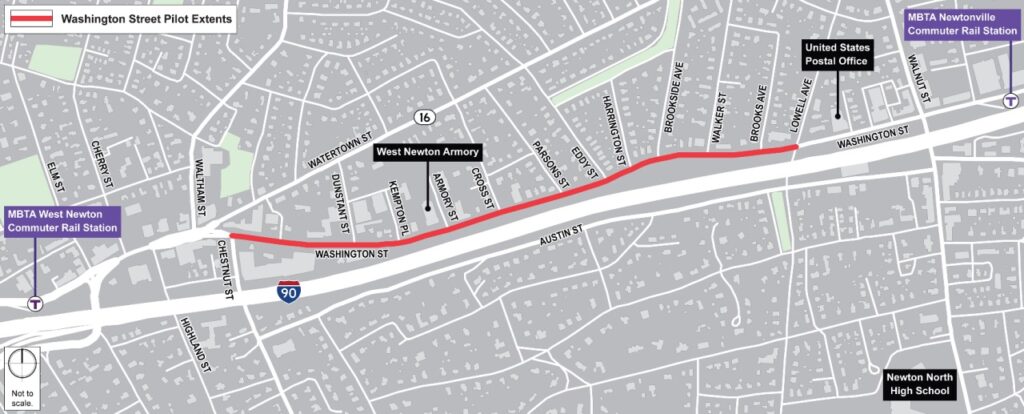WashingtonStDesign1
Design concept for Washington Street after pilot project. Newton Planning Department
PHOTO: Design concept for Washington Street after pilot project. Newton Planning Department
As spring brings roadwork, building renovations and the beginnings of major renovation and development projects, swaths of Washington Street are being eyed for big changes and cultural rebirth on the horizon.
The Washington Street Pilot project is making its way through the City Hall approval process while local cultural leaders are pushing for a cultural district along that same street in West Newton and Newtonville.
If the efforts are successful, in a couple of years Washington Street will emerge from a metaphorical cocoon as a bicycle-friendly butterfly of modern urban renewal.
Test now, invest later
Newton Planning Director Barney Heath and Deputy Director Jenn Caira met with the City Council’s Public Facilities Committee Wednesday night to discuss the planned remodel of a portion of Washington Street.
Commonly called the Washington Street Pilot, this project emerged in the Washington Street Vision Plan adopted by the City Council in 2019 and will cover about three quarters of a mile of Washington Street between Chestnut Street and Lowell Avenue, connecting West Newton and Newtonville.
The goals include making that highly traveled area safer for drivers, pedestrians and cyclists as well as attracting more visitors to shop and eat there.
“To achieve these goals, we’ll be creating a two-to-three-lane roadway, looking to reduce speeds, reduce conflicts and reduce the likelihood of injuries,” Caira said, “and also by improving pedestrian/bicycle connectivity and comfort, retaining parking to the greatest extent possible and increasing the greenery and landscaping along the corridor.”
The Planning Department—in collaboration with city councilors, consultants and the Division of Public Works—started researching, collecting public feedback and laying groundwork for the project last year.
After that work is done, the city will look at possible improvements to other areas of Washington Street, including the stretch from West Newton to Wellesley and from Newtonville to the eastern edge of the city.
The initial work is called a “pilot” because it’s sort of an experiment, or as Caira put it Monday, to “test before we invest.”
The work being done under the pilot is largely temporary—things like pavement markings, signs, flex posts and other low-cost components—that can be easily removed for a permanent project down the line.
“The Vision Plan suggests testing a redesign along a portion of Washington Street first before investing the time and resources into permanent improvements,” Caira said. “And the permanent design will require state funding, so this pilot allows us to relatively quickly and inexpensively test some concepts while also making improvements to a section of Washington Street that really suffers from high speeds and poor pedestrian infrastructure.”
With the pilot, that portion of Washington Street will have one travel lane in each direction with additional left turn lanes, a buffered shared-use path along the south side adjacent to the Turnpike and new landscaping along the Turnpike. There will be some parking spots removed to the fit left-turn lanes.
The Planning Department will present its updates and project plans to the full City Council next, and construction is set to begin next year.
The entire Washington Street Pilot presentation is on YouTube.

Arts, culture and an economic engine
As that project moves forward, there’s an effort by leaders from Newton Community Pride, the Newton Cultural Alliance, the New Art Center and the Charles River Regional Chamber to get part of Washington Street designated as a cultural district through the Massachusetts Cultural Council.
The plan is to turn the part of Washington Street that connects West Newton and Newtonville into a local destination with more shops, restaurants, art space and foot traffic.
“Anchored by the New Art Center in Newtonville and the Allen Center for the Arts in West Newton, the proposed Cultural District would highlight several arts/cultural assets including the Jackson Homestead and Museum, public art murals, creative businesses, and performing arts venues,” a letter submitted to City Hall in December reads.
Advocates for the cultural district have been meeting with city leaders and the public in the months since, hoping to build support for what they say could greatly benefit the whole city culturally and economically.
“As an artist, the establishment of a district really sends a signal that the community is behind you in creating an identity and place for cultural activities to be focused and also funded in certain ways,” John Rufo, architect and chair of the board of the Charles River Regional Chamber, said at a League of Women Voters presentation in March.
“As an urban designer–and I’ve worked on a few projects here in Newton–I think the ability of the public to visualize a place like a district for arts and culture really helps bring into consciousness the roles of arts and culture in our lives and in the community every day.”
Newton Community Pride Co-Chair Meryl Kessler met with the city’s Economic Development Commission to present the cultural district proposal to them.